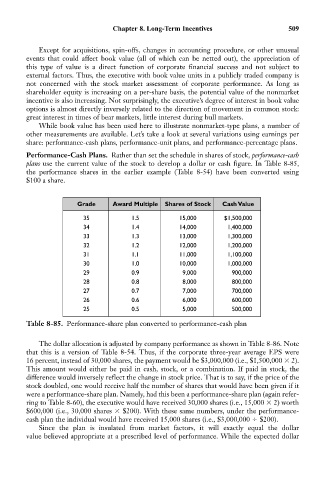Page 523 - Bruce Ellig - The Complete Guide to Executive Compensation (2007)
P. 523
Chapter 8. Long-Term Incentives 509
Except for acquisitions, spin-offs, changes in accounting procedure, or other unusual
events that could affect book value (all of which can be netted out), the appreciation of
this type of value is a direct function of corporate financial success and not subject to
external factors. Thus, the executive with book value units in a publicly traded company is
not concerned with the stock market assessment of corporate performance. As long as
shareholder equity is increasing on a per-share basis, the potential value of the nonmarket
incentive is also increasing. Not surprisingly, the executive’s degree of interest in book value
options is almost directly inversely related to the direction of movement in common stock:
great interest in times of bear markets, little interest during bull markets.
While book value has been used here to illustrate nonmarket-type plans, a number of
other measurements are available. Let’s take a look at several variations using earnings per
share: performance-cash plans, performance-unit plans, and performance-percentage plans.
Performance-Cash Plans. Rather than set the schedule in shares of stock, performance-cash
plans use the current value of the stock to develop a dollar or cash figure. In Table 8-85,
the performance shares in the earlier example (Table 8-54) have been converted using
$100 a share.
Grade Award Multiple Shares of Stock Cash Value
35 1.5 15,000 $1,500,000
34 1.4 14,000 1,400,000
33 1.3 13,000 1,300,000
32 1.2 12,000 1,200,000
31 1.1 11,000 1,100,000
30 1.0 10,000 1,000,000
29 0.9 9,000 900,000
28 0.8 8,000 800,000
27 0.7 7,000 700,000
26 0.6 6,000 600,000
25 0.5 5,000 500,000
Table 8-85. Performance-share plan converted to performance-cash plan
The dollar allocation is adjusted by company performance as shown in Table 8-86. Note
that this is a version of Table 8-54. Thus, if the corporate three-year average EPS were
16 percent, instead of 30,000 shares, the payment would be $3,000,000 (i.e., $1,500,000 2).
This amount would either be paid in cash, stock, or a combination. If paid in stock, the
difference would inversely reflect the change in stock price. That is to say, if the price of the
stock doubled, one would receive half the number of shares that would have been given if it
were a performance-share plan. Namely, had this been a performance-share plan (again refer-
ring to Table 8-60), the executive would have received 30,000 shares (i.e., 15,000 2) worth
$600,000 (i.e., 30,000 shares $200). With these same numbers, under the performance-
cash plan the individual would have received 15,000 shares (i.e., $3,000,000 $200).
Since the plan is insulated from market factors, it will exactly equal the dollar
value believed appropriate at a prescribed level of performance. While the expected dollar

